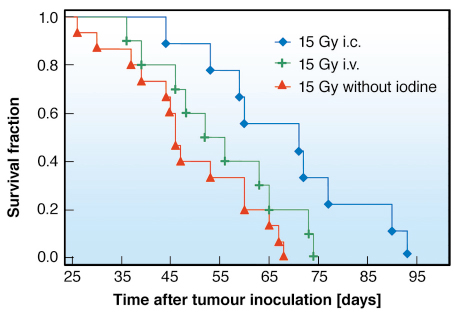- Home
- Users & Science
- Scientific Documentation
- ESRF Highlights
- ESRF Highlights 2006
- X-ray Imaging and Optics
- Prolonged survival of Fischer rats bearing F98 glioma after iodine-enhanced synchrotron stereotactic radiotherapy
Prolonged survival of Fischer rats bearing F98 glioma after iodine-enhanced synchrotron stereotactic radiotherapy
Primary brain tumours are one of the ten main causes of death from cancer. Despite aggressive treatment with surgery, radiation and chemotherapy, most patients with these tumours have a less than 2-year survival time after diagnosis. A fundamental goal of radiation therapy is to deliver a high therapeutic dose of ionising radiation to the tumour without exceeding the tolerance of normal tissues surrounding the lesion. Various techniques have been proposed in clinics for producing highly-localised dose distribution. None has given outstanding results so far. Synchrotron stereotactic radiotherapy (SSR) is an innovative radiation therapy technique, where the tumour is loaded with a high-Z element (iodinated contrast agents or platinated chemotherapeutic drugs) and irradiated in stereotactic conditions with monochromatic X-rays from a synchrotron source (tens of eV energy bandwidth), tuned to the optimal energy [1, 2]. The irradiation geometry, the fluorescent X-rays, photoelectrons, and Auger electrons generated on iodine atoms, produce a localised dose enhancement. The purpose of this study was to determine whether the efficacy of iodine-enhanced-SSR could be further improved by using a concomitant injection of an iodinated contrast agent and a transient blood brain barrier opener (mannitol).
Fourteen days after intracerebral inoculations of F98 cells, the animals were irradiated with 50 keV monochromatic X-rays (0, 5, 15 or 25 Gy in a single fraction) while receiving an infusion of hyperosmotic mannitol with iodine, either intravenously or via the carotid (9 to 15 rats per group, 117 rats total). The experiments were performed at the Biomedical Beamline ID17.
A theoretical iodine dose enhancement factor (DEF) was calculated as the ratio of the radiation dose absorbed by the tumour when it is loaded with contrast media (CM) to the dose absorbed without CM. The radiation dose is the energy (J) deposited by the radiation beam per kg of tissue, with no assumption concerning the probability for a given particle to have a lethal effect at the cellular level. The possible biological damage follows after the physical interactions between radiation and atoms or molecules of the cells. Another index, the “iodine biological enhancement factor” (IBEF) was defined. It corresponds to the apparent biological enhancement with iodine and reflects the overall consequences of the treatment, which includes the effects of an increased physical energy absorption, as well as other radiobiological factors, due to the presence of the high-Z element.
The endpoint of the study was the survival time of the rats after tumour implantation, for a given treatment. The mean survival times, median survival times and increased life spans (ILS = percentage of survival increase relative to the mean or median survival of untreated controls) were calculated for each group.
In the absence of iodine, the mean and median survival times were found to increase with radiation dose. The ILS relative to the median increases exponentially (R2 = 0.999) within the X-ray dose range 5 to 25 Gy. For tumour X-ray doses inferior to 25 Gy, the intracarotid (i.c.) infusion of mannitol and iodine during SSR improved the survival of rats compared to intravenous injection (i.v.) or irradiation alone (Figure 124). Mean survival times (mean ± SD) were 25.6 ± 2.4, 48.9 ± 13.1 (ILS = 91%), and 55.2 ± 13.4 (ILS = 116%), 68.8 ± 16.4 days (ILS = 169%) for untreated controls, irradiated without iodine, irradiated after infusion of iodine and mannitol i.v. and i.c., respectively (15 Gy). For X-ray doses of 25 Gy, the rats irradiated without iodine had the longest survival (ILS = 607%), but no additional benefit was obtained when iodine and mannitol were injected (ILS = 113% and 78%, after i.v. and i.c. injection respectively). The IBEF was found equal to be 1.69 and 1.13 for 5 and 15 Gy, respectively (i.v. route, theoretical DEF = 1.68). For the i.c. route, we obtained 1.85 and 1.30 for 5 and 15 Gy, respectively (theoretical DEF = 4.11).
 |
|
Fig. 124: Kaplan-Meier survival curves of F98 glioma-bearing rats treated with stereotactic synchrotron radiation therapy (15 Gy) without contrast agent injection or with iodinated contrast agent (Iomeron) and mannitol injection during irradiation (intravenous and intra-arterial). The irradiation was performed with 50 keV monochromatic X-rays. The untreated controls (curve not shown) had a mean survival time of 25.6 ± 2.4 days (range: 21 – 28 days, median: 26 days). |
These preclinical findings demonstrate that the efficacy of iodine-enhanced-SSR is significantly improved with the concomitant intracarotid infusion of iodine and mannitol for radiation doses less or equal to 15 Gy.
References
[1] Adam JF, Elleaume H, Joubert A, et al. Int J Radiat Oncol Biol Phys. 57, 1413-1426 (2003).
[2] Biston MC, Joubert A, Adam JF, et al. Cancer Res. 64 2317-2323 (2004).
Principal Publication and Authors
JF. Adam (a,b), A. Joubert (a), M.C. Biston, A.M. Charvet, M. Peoc’h (c), J.F. Le Bas (a,b,d), J. Balosso (a,b,e), F. Estève (a,b,d) and H. Elleaume (a), Int J Radiat Oncol Biol Phys 64(2), 603-611 (2006).
(a) INSERM U647, Medical Beamline ID17, ESRF
(b) Université Joseph Fourier, Grenoble (France)
(c) Centre Hospitalier Bellevue, Département de pathologie, Saint Etienne (France)
(d) CHRU Grenoble, Hôpital Michallon, Unité IRM, Grenoble (France)
(e) CHRU Grenoble, Hôpital Michallon, Département de Cancérologie et d’Hématologie, Grenoble (France)



